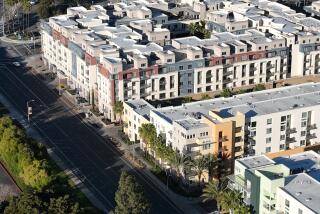New California law aims to cultivate urban agriculture
SAN FRANCISCO — Sandwiched between rows of homes in the fog-kissed Mission Terrace neighborhood, Little City Gardens provides salad greens and fresh-cut flowers to local restaurants from what was once a weedy vacant lot.
Like many of California’s urban agriculture practitioners, however, Caitlyn Galloway is plagued by a key uncertainty: She is on a month-to-month lease with a landlord who must recoup the lot’s steep property taxes and may soon sell or develop.
Now, California cities and counties eager to encourage community gardens and small-scale farms in urban pockets have a novel tool at their disposal that could help solve Galloway’s problem. Legislation recently signed by Gov. Jerry Brown will allow municipalities to lower the assessed value — and property taxes — on plots of three acres or less if owners pledge to dedicate them to growing food for at least five years.
“As urban farmers one of the biggest obstacles we’ve faced is land tenure,” said Galloway, 32. “It’s a huge step for urban agriculture.”
The legislation authored by Assemblyman Phil Ting (D-San Francisco) arose from this city’s rich blend of urban ag interests: community gardens with long waiting lists, nonprofits that offer hands-on nutritional education, and small enterprises like Galloway’s that took root when officials here changed zoning laws.
The program is voluntary: Interested cities can now move forward to create “urban agriculture incentive zones.” County supervisors must then sign off. (Counties can also directly create their own zones.)
It passed the Senate unanimously and garnered just six no votes in the Assembly. Sole opposition came from the California Assessors’ Assn., which cited potential for abuse by corporate property owners who might cut deals with local government. The bill was later amended to curtail lot size.
Local governments that opt in would feel most of the pain of lost property tax revenue, while the Senate Appropriations Committee estimated the general fund hit at “less than $1 million” in increased school aid annually.
Ting, a former San Francisco assessor, described it as “a subsidy with a very limited fiscal impact. We’re trying to drive better land use for people who might have a parking lot or an empty lot they’re waiting to develop.”
For years, Ting had backed cutting-edge San Francisco policies that helped transform eyesore parcels, raising property values on entire blocks. The idea spread.
“We started to see a movement in cities all over California that have really decided they want to be growing their food,” he said. “They want to have access to agricultural space.”
The concept for the zones is a hybrid of the Wiliamson Act, which offers tax subsidies to owners of rural land maintained for agricultural purposes, and the Mills Act, under which cities may enter into contracts with private owners who receive subsidies in exchange for restoring and preserving historic buildings.
It was conceived by Nicholas Reed and Juan Carlos Cancino, Stanford Law School grads who helped launch the San Francisco Greenhouse Project, an effort to turn a lot dotted with 18 decrepit greenhouses in the Portola district into an urban agriculture showcase.
The pair also took an interest in Little City Gardens, helping Galloway with number crunching. Even if she could afford the million-dollar cost of the property she cultivates, property taxes could easily sink her. The property owner wrote a letter in support of the bill but his next steps are unclear.
They concluded that if the city wanted urban farms that didn’t rely on public land, or heavy philanthropic support, “we need to see some change in the tax law that would recognize a different use — that this wasn’t a residential or commercial use but an agricultural one,” Cancino said.
They turned to Eli Zigas, food systems and urban agriculture program manager for SPUR, a San Francisco urban planning organization. Zigas is also a member of the San Francisco Urban Agriculture Alliance — which ultimately became the bill’s sponsor — and invited Ting to hear Cancino and Reed present their idea.
Support flowed in from organizations in Sacramento, Oakland, East Palo Alto and San Diego, as well as more than half a dozen in Los Angeles County.
“Land is a premium, particularly when you have empty parcels going for hundreds of thousands of dollars,” said D’Artagnan Scorza, executive director of the Inglewood-based Social Justice Learning Initiative, who called the law a “huge market incentive for land owners who are not intending to do development.”
Scorza’s organization has already created 40 gardens in Los Angeles that donate the food they grow to needy families who live where supermarkets are scarce. They are predominantly located at schools or on other public land as well as in private yards. But the organization hopes to create a commercial farm that will create jobs while funding its educational efforts and food giveaways.
His next step is to lobby Los Angeles lawmakers to get onboard.
Elsewhere, Sacramento city officials supported the bill and have expressed interest in participating in the program, as has San Francisco Supervisor David Chiu, who is moving forward to seek local approval.
“We simply want to create the impetus and awareness for property owners that this is a viable and productive use of land,” Chiu said. “This is an option many communities are excited about.”
More to Read
Sign up for Essential California
The most important California stories and recommendations in your inbox every morning.
You may occasionally receive promotional content from the Los Angeles Times.











